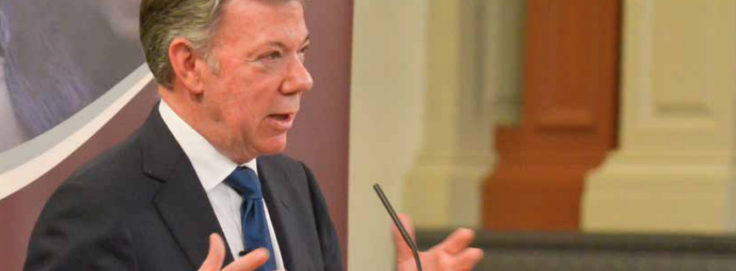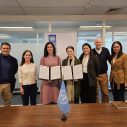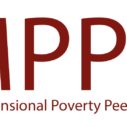
Search
‘I saw that this index [MPI] would give me the tools to have a much more efficient public investment.’

Colombia is at the forefront globally in multidimensional poverty measurement. Not only was the country a pioneer in creating the national Multidimensional Poverty Index (CO-MPI), Colombia also uses this indicator to better monitor poverty goals and the Sustainable Development Goals. Sabina Alkire, Director of OPHI, spoke about these issues with former President Juan Manuel Santos, who is currently a visiting professor at the Department of International Development of Oxford University.
Sabina Alkire (SA): It is an honour to be with Juan Manuel Santos of Colombia, who five years ago in Oxford, launched the Multidimensional Poverty Peer Network, which also included a public distinguished lecture by Amartya Sen, and so my first question is about the relationship between Amartya Sen and his work, and the multidimensional poverty index that you have used so much in Colombia.
Juan Manuel Santos (JMS): Thank you very much for having me. The relationship with Amartya Sen was more of a personal and inspirational relationship because he was my professor many years ago in London at the London School of Economics and then at Harvard, and he made a tremendous impression on me – what he taught and his ideas.
So when we started – my government – my first government and we put the fight against poverty as a priority, and we heard about the new approach – the multidimensional index, an idea inspired by Professor Sen – that immediately caught my attention and my enthusiasm. And we put this policy as part of our National Development Plan, which is a law that Congress has to approve, and then we came to Oxford some years later – in 2013 – to launch the network. But by that time we had already started the implementation of our policy and our fight against poverty, which was based on the multidimensional index not on the monetary indicators – even though we maintained those measurements in order to give people the confidence that we were not manipulating the statistics.
SA: Colombia has been a leader worldwide in the implementation of the MPI. I would like to deepen our understanding of how it became a tool. You first mentioned that Colombia had an income poverty measure, so why did you decide to use an MPI and what were some of the obstacles in communicating it?
JMS: I decided to use the MPI because it was logical and reasonable, and I had my concerns about why the monetary indicator was not the correct indicator. Among other things, I read what Professor Sen had said about this, and it’s a simply a logical conclusion that it’s not how much money we receive, but if you have access to health, if you have access to education, the conditions you live in. These are the real dimensions of poverty – what defines if you’re poor or not. So I thought that this is a much better way and we went ahead with constructing the index in Colombia.
We decided at the same time to maintain the other index in order to avoid the accusation that we were simply changing the index to make the government more look efficient in fighting against poverty. To which we said: ‘No, we will maintain the other index, but this index will help me’. I was Minister of Finance before being president. I know how important it is to identify where your investments, especially your social investments, will be more profitable, will have a better impact, and so I saw that this index would give me the tools to have a much more efficient public expenditure or public investment in the social aspect. And it did, because we could decide where the money will have a better impact in our fight against poverty, and the fight against poverty was our priority.
I decided to use the MPI because it was logical and reasonable, and I had my concerns about why the monetary indicator was not the correct indicator.
It had a tremendous attraction from the logical point of view. You don’t have to be an economist or have a PhD to conclude that this indicator was more useful and, at the same time, from the public expenditure point of view, it was ideal for making public expenditure or public investment more efficient.
SA: Thank you so much. You’ve talked about the public investment, but another one of the features of Colombia’s implementation that captures the imagination of other countries is how you used the MPI to coordinate policies. So could you talk a little bit more about that?
JMS: Any public policy – and I even founded a foundation called Good Government Foundation – any public policy needs a correct coordination among the institutions, the political will of the leaders, to really have success. Since this was my priority, then I myself organised a committee. The ministers who were responsible for attacking poverty with all the indicators of the multidimensional index, they were seen around a table. And not only the ministers, but the institutions that had something to do with this public policy – and they reported to the president. They cannot send a vice-minister or any other employee of their institutions; it had to be at the highest level. They had to give me information on how they were advancing in the implementation of the policy.
This was extremely important because the coordination and the pressure from above to have results and monitoring the advance – and why is somebody lagging here or there – is the essence of good government. We applied that to the implementation of the multidimensional index in our fight against poverty with tremendously successful results. The results speak for themselves: more than five and a half million Colombians came out of multidimensional poverty in the last five to six years.
SA: Colombia, in a sense, was the first country to propose the Sustainable Development Goals and to use them in the national development plans, so can you speak a little bit about your role in that process and their importance?
JMS: When I was inaugurated as president back in 2010, a girl gave me a very bad welcome, a girl called ‘La Niña’. It was the worst phenomenon of La Niña that we have ever experienced. Colombia was completely flooded for two years. It rained and rained and rained. That made me much more conscious of climate change. Colombia is a very rich country in terms of biodiversity. I remember Vice President Gore going to Colombia and telling me ‘You are one of the most vulnerable countries, because you are so rich in biodiversity, and if the temperatures continue to increase, your biodiversity will be destroyed’.
So I was very conscious of this issue, and also I transmitted this worry to the people of my government. And two very intelligent fine ladies that work for my government came to me with an idea and said ‘President Santos, you’re worried about the environment. We have to change the Millennium Goals to some new goals. We have this idea: Why don’t we call them the Sustainable Development Goals? Because the environment must be an element in the new goals and, also, this is not a problem of poor countries or developing countries, it’s a problem of the whole world, so the developed countries must be present in these new goals’. I told them to give me some ideas; I took them to the summit, the Rio summit, that took place in Rio de Janeiro in 2012. I presented the proposal to the plenary of the summit, and it immediately sort of caught the attention of many of the principal delegations.
I remember China was chairing this meeting and he told me ‘You come from a relatively small country’, and I said ‘We’re not that small but compared to China we are’. And he said ‘But you have big ideas, this is a great idea’. And then a process of diplomacy followed, diplomacy with many countries wanting to participate in discussions – how many goals, what goals.
It was a fascinating experience of choosing the 17 goals and finally in the year 2015, I had a tremendous pleasure and privilege of being president when the UN General Assembly adopted the SDGs as the world agenda for the future.
This article was published in Dimensions Magazine 6 (PDF).
Thanks to Jasmine Hoyt (UNV) for this interview transcription.
















